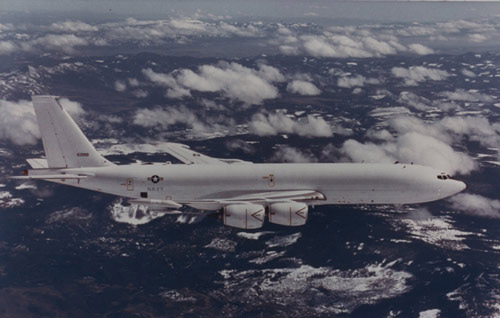E-6 Mercury TACAMO
Summary
| Category | Military Special Mission Aircraft |
| Origin country | 🇺🇸 United States |
| Manufacturer | Boeing |
| First flight | 19 February 1987 |
| Year introduced | 1989 |
| Number produced | 16 units |
| Average unit price | $141 million |
Description
Adapted from the Boeing 707-320 airliner, the E-6 development commenced, resulting in the first E-6, originally named Hermes, emerging from Boeing's Renton Factory in December 1986. Its first flight was in February 1987, relocating to Boeing Field for mission avionics installation. After delivery to the Navy for testing in July 1988, the E-6A entered service with squadron VQ-3 in August 1989. A second squadron, VQ-4, received its first E-6As in January 1991, allowing the EC-130Q to be phased out in June 1991. The E-6A was renamed Mercury in autumn 1991 at the Navy’s request. Sixteen E-6A planes were delivered from 1988 to 1992. All 16 E-6A aircraft were later modified to the E-6B standard, with the final delivery taking place in December 2006. Production of the E-6 concluded in 1991, marking it as the last new variant of the Boeing 707 to be manufactured. The E-6 fleet is stationed at Tinker Air Force Base, Oklahoma, and operated by Fleet Air Reconnaissance Squadrons VQ-3, VQ-4, and VQ-7.
The E-6 is notable for its flying boom receptacle on the upper-forward fuselage, allowing it to be refueled by the U.S. Air Force’s fleet of KC-135 Stratotankers, KC-10 Extenders, and KC-46 Pegasuses. The flight deck systems were replaced with a 737 Next Generation cockpit. The avionics suite includes the AN/ARC-182 VHF/UHF TxRx, AN/ARC-190 HF, AN/AIC-32 Crew Intercom, a triplex Litton LTN-90, LTN-211 VLF/Omega, Smiths SFM 02 digital/analog flight management system, and AN/APS-133 color weather radar. The E-6B upgrade includes a battle staff area and updated mission equipment.
The E-6 Mercury is not directly involved in offensive operations and therefore lacks conventional armament. Its primary function centers on communication and command, particularly within the context of nuclear deterrence. Codenamed Looking Glass, the E-6 serves as United States Strategic Command's Airborne Command Post and is designed to take over command if the Global Operations Center becomes inoperable. The E-6B variant possesses the Airborne Launch Control System, enabling it to remotely control Minuteman ICBMs. The aircraft's extensive suite of communication equipment and mission systems take precedence.
Main Variants:
-
E-6A: The original production model, tasked with relaying instructions to fleet ballistic missile submarines via TACAMO.
-
E-6B: An upgraded version of the E-6A, equipped with Airborne Launch Control System capability for remote control of Minuteman ICBMs.
-
E-6 Trainer: A conversion of a Royal Air Force E-3D Sentry, intended to extend the life of the operational fleet by reducing the use of E-6s for training missions.
Technical specifications
| Version: E-6B Mercury | |
|---|---|
| Crew | 22 members |
| Operational range | 12,000 km (7,456 mi) |
| Maximum speed | 966 km/h (600 mph) |
| Wingspan | 45.2 m (148.3 ft) |
| Height | 12.9 m (42.3 ft) |
| Length | 45.8 m (150.3 ft) |
| Service ceiling | 12,192 m (40,000 ft) |
| Max. takeoff weight | 155,128 kg (341,998 lbs) |
| Powerplant | 4 x turbojets CFM International CFM56-2A-2 delivering 11213 kgf each |
Current operating countries
| Country | Units | ||
|---|---|---|---|

|
United States | 16 | |
All operators
